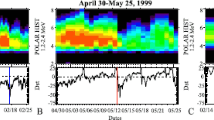Abstract
The results of measurements of fluxes and spectra carried out using the RELEC (relativistic electrons) equipment onboard the VERNOV satellite in the second half of 2014 are presented. The VERNOV satellite was launched on July 8, 2014 in a sun-synchronous orbit with an altitude from 640 to 830 km and an inclination of 98.4°. Scientific information from the satellite was first received on July 20, 2014. The comparative analysis of electron fluxes using data from RELEC and using experimental data on the electron detection by satellites Elektro-L (positioned at a geostationary orbit) and Meteor-M no. 2 (positioned at a circular polar orbit at an altitude of about 800 km as the VERNOV satellite) will make it possible to study the spatial distribution pattern of energetic electrons in near-Earth space in more detail.
Similar content being viewed by others
References
Shprits, Y.Y., Meredith, N.P., and Thorne, R.M., Parameterization of radiation belt electron loss timescales due to interactions with chorus waves, Geophys. Res. Lett., 2007, vol. 34, L11110. doi 10.1029/2006GL029050
Shprits, Y.Y., Subbotin, D., Ni, B., et al., Profound change of the near-Earth radiation environment caused by solar superstorms, Space Weather, 2011, vol. 9, no. 8. doi 10.1029/2011SW000662
Turner, D.L., Shprits, Y.Y., Hartinger, M., et al., Explaining sudden losses of outer radiation belt electrons during geomagnetic storms, Nature Phys., 2012, vol. 8, pp. 208–212. doi 10.1038/nphys2185
Antonova, E.E., Myagkova, I.N., Stepanova, M.V., et al., Local particle traps in the high latitude magnetosphere and the acceleration of relativistic electrons, J. Atmos. Sol.–Terr. Phys., 2011, vol. 73, nos. 11–12, pp. 1465–1471. doi 10.1016/j.jastp.2010.11.020
Brautigam, D.H. and Albert, J.M., Radial diffusion analysis of outer radiation belt electrons during the 9 October, 1990, magnetic storm, J. Geophys. Res., 2000, vol. 105, no. A1, pp. 291–309. doi 10.1029/1999JA900344
Selesnick, R.S. and Blake, J.B., On the source location of radiation belt relativistic electrons, J. Geophys. Res., 2000, vol. 105, no. A2, pp. 2607–2624. doi 10.1029/1999JA900445
Reeves, G.D., McAdams, K.L., Friedel, R.H.W., et al., Acceleration and loss of relativistic electrons during geomagnetic storms, Geophys. Res. Lett., 2003, vol. 30, p. 1529. doi 10.1029/2002GL016513
Iucci, N., Leviti, A.E., Belov, A.V., et al., Space weather conditions and spacecraft anomalies in different orbits, Space Weather, 2005, vol. 3, no. 1, p. S01001. doi 10.1029/2003SW000056
Romanova, N. and Pilipenko, V., ULF wave indices to characterize the solar wind–magnetosophere interaction and relativistic electron dynamics, Acta Geophys., 2008, vol. 57, no. 1, pp. 158–170.
Nagata, K., Kohno, T., Murakami, H., et al., Electron (0.19–3.2 MeV) and proton (0.58–35 MeV) precipitations observed by OHZORA satellite at low zones L = 1.6–1.8, Planet. Space Sci., 1988, vol. 36, pp. 591–606.
Bashkirov, V.F., Denisov, Y.I., Gotselyuk, Y.V., et al., Trapped and quasi-trapped radiation observed by CORONAS-I satellite, Radiat. Meas., 1999, vol. 30, no. 5, pp. 537–546.
Kuznetsov, S.N. and Myagkova, I.N., Quasi-trapped electron fluxes (>0.5 MeV) under the radiation belts: Analysis of their connection with geomagnetic indices, J. Atmos. Sol–Terr. Phys., 2002, vol. 64, nos. 5–6, pp. 601–605.
Kuznetsov, S.N., Myagkova, I.N., Yushkov, B.Yu., et al., Dynamics of the Earth’s radiation belts during strong magnetic storms according to KORONAS-F satellite data, Astron. Vestn., Issled. Sol. Sist., 2007, vol. 41, no. 4, pp. 350–359.
Kuznetsov, S.N., Yushkov, B.Yu., Kudela, K., et al., Dynamics of the Earth’s radiation belts during the magnetic storm of November 6th, Adv. Space Res., 2005, vol. 36, no. 10, pp. 1997–2002.
Kuznetsov, S.N. and Myagkova, I.N., Energetic trapped proton and electron flux variations at low altitudes measured onboard CORONAS-I satellite, their connection with the particle flux variations in geostationary orbit, Adv. Space Res., 2002, vol. 30, no. 10, pp. 2319–2323.
Kuznetsov, S.N. and Myagkova, I.N., Energetic trapped proton and electron flux variations at low altitudes measured onboard CORONAS-F satellite during 2001, August–December, their connection with the particle flux variations in geostationary orbit, Geophys. Monogr. Ser., 2005, vol. 155, pp. 121–125.
Sergeev, V., Nishimura, Y., Kubyshkina, M., et al., Magnetospheric location of the equatorward prebreakup arc, J. Geophys. Res., 2012, vol. 117, A01212. doi 10.1029/2011JA017154
Sergeev, V.A., Yakhnin, A.G., and Pellinen, R., Mutual location and magnetospheric sources of intrusion zones of energetic electrons, diffusive and discrete auroras in the substorm preparatory phase, Geomagn. Aeron., 1983, vol. 23, no. 6, pp. 972–978.
Yahnin, A.G., Sergeev, V.A., Gvozdevsky, B.B., and Vennerstrom, S., Magnetospheric source region of discrete auroras inferred from their relationship with isotropy boundaries of energetic particles, Ann. Geophys., 1997, vol. 15, pp. 943–958.
Riazantseva, M., Myagkova, I.N., Karavaev, M.V., et al., Enhanced energetic electron fluxes at the region of the auroral oval during quiet geomagnetic conditions November 2009, Adv. Space Res., 2012, vol. 50, no. 5, pp. 623–631.
Author information
Authors and Affiliations
Corresponding author
Additional information
Original Russian Text © I.N. Myagkova, M.I. Panasyuk, S.I. Svertilov, V.V. Bogomolov, A.V. Bogomolov, V.V. Kalegaev, V.O. Barinova, E.A. Balan, 2016, published in Kosmicheskie Issledovaniya, 2016, Vol. 54, No. 1, pp. 73–81.
Rights and permissions
About this article
Cite this article
Myagkova, I.N., Panasyuk, M.I., Svertilov, S.I. et al. Electron flux variations at altitudes of 600–800 km in the second half of 2014. preliminary results of an experiment using RELEC equipment onboard the satellite VERNOV . Cosmic Res 54, 67–75 (2016). https://doi.org/10.1134/S0010952516010135
Received:
Published:
Issue Date:
DOI: https://doi.org/10.1134/S0010952516010135




